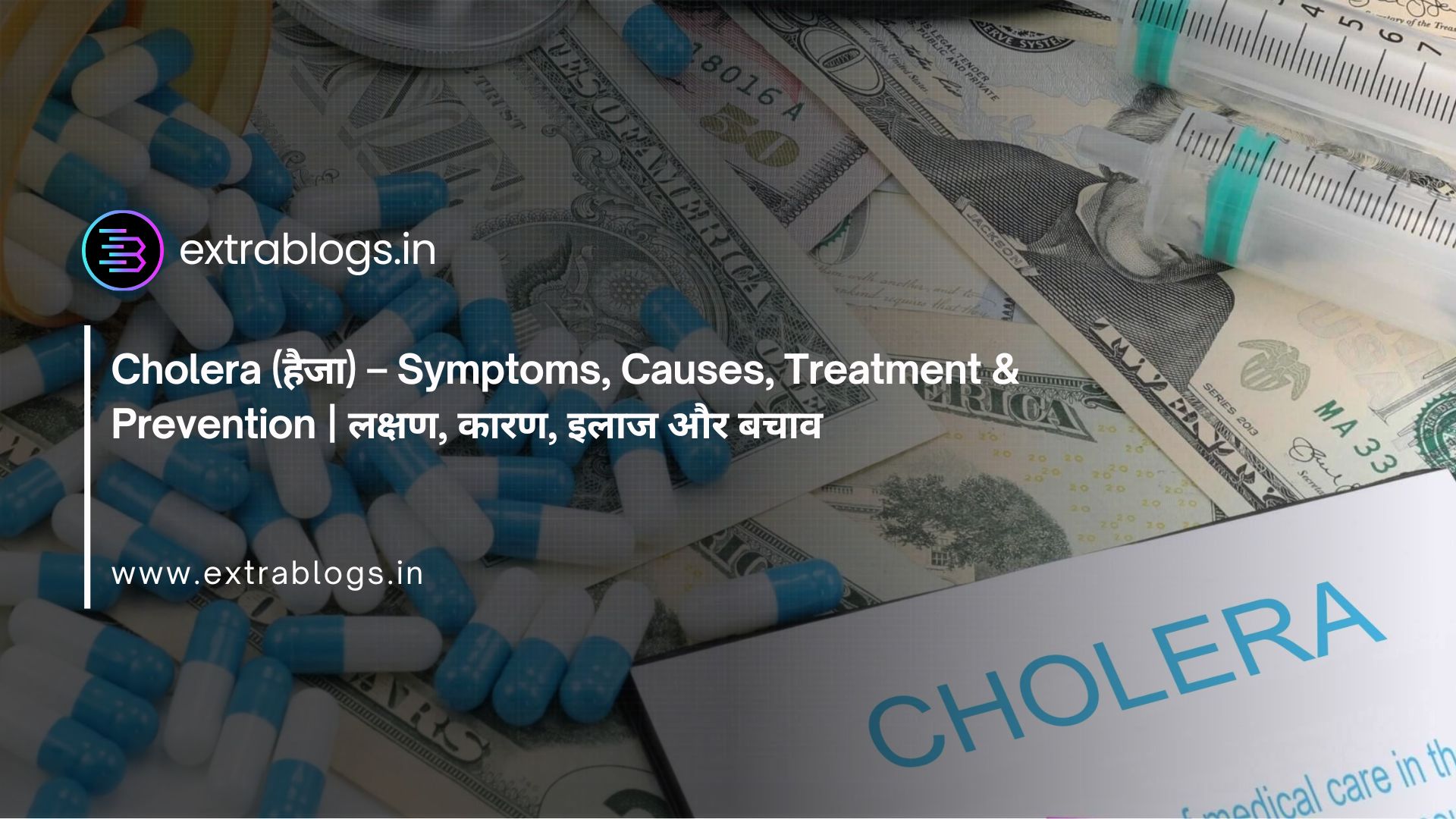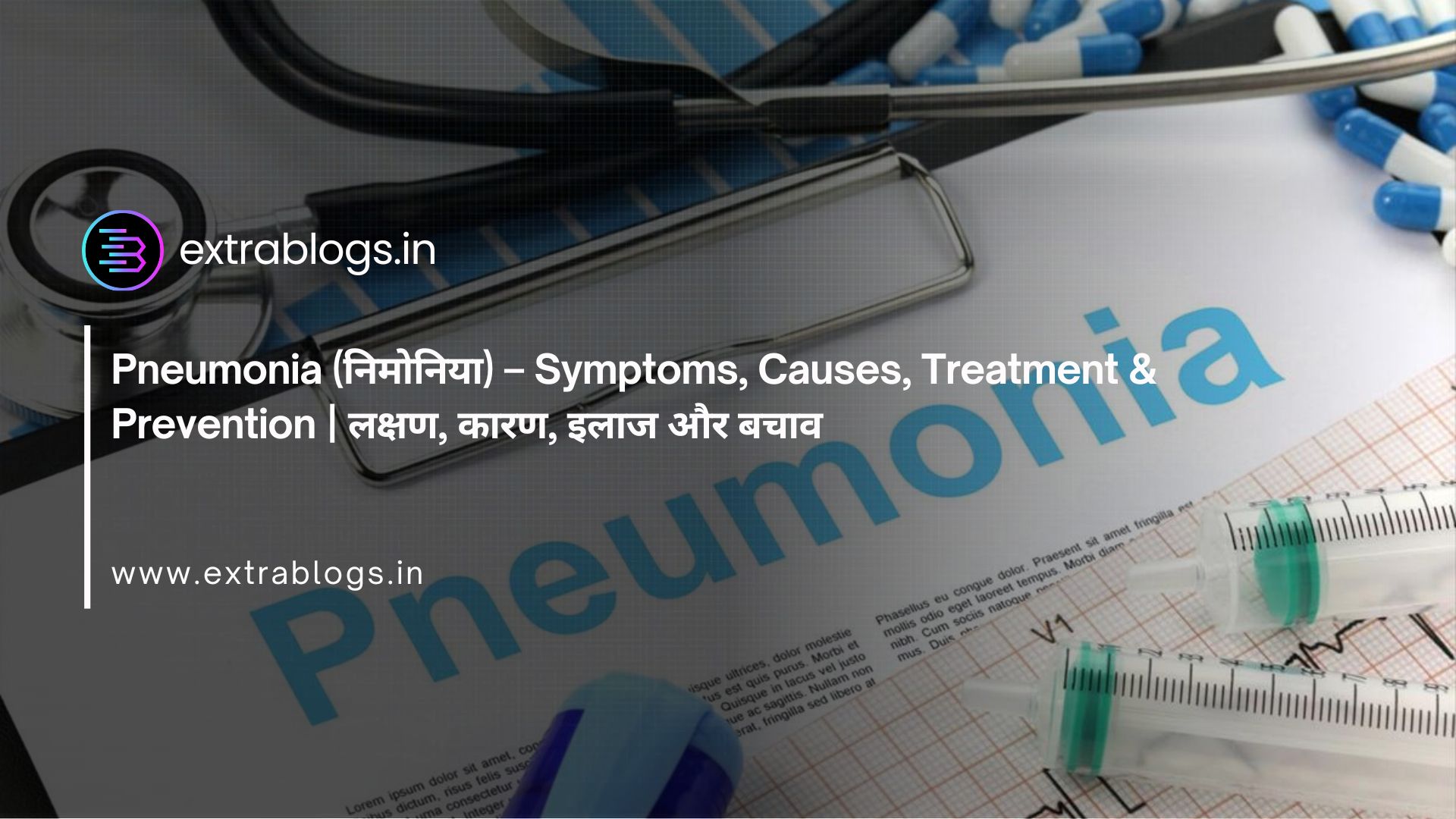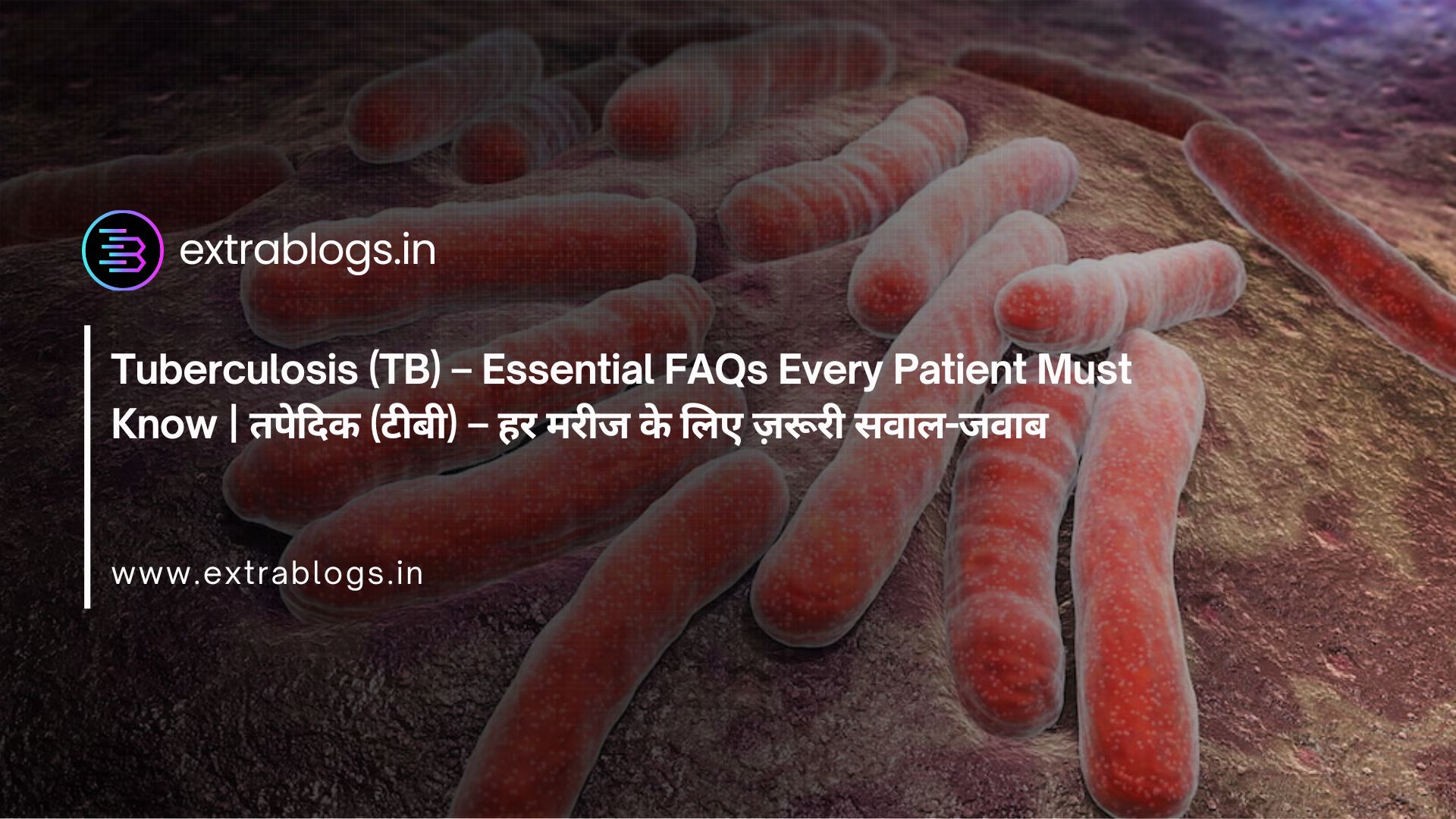Cholera (हैजा) – Symptoms, Causes, Treatment & Prevention | लक्षण, कारण, इलाज और बचाव
Cholera: A Detailed Guide
Cholera is a life-threatening infectious disease caused by the bacterium Vibrio cholerae. It primarily spreads through contaminated water and food, leading to acute diarrheal illness, severe dehydration, and, in extreme cases, death. Despite significant progress in medical science, cholera continues to be a persistent health challenge, especially in regions with inadequate sanitation and clean water access. Understanding the disease in its entirety—its history, causes, symptoms, treatment, prevention, and global impact—is crucial for effective control and eradication.
The History of Cholera and Its Global Impact
Cholera has shaped human history through multiple pandemics, each leaving a devastating impact on societies. The first known cholera outbreak was recorded in India in the early 19th century, and since then, it has spread across continents, affecting millions. The disease thrives in overcrowded and unhygienic environments, making it particularly deadly in refugee camps, war zones, and impoverished communities. Major cities such as London and New York faced severe cholera outbreaks in the 19th century, which led to advancements in public health and sanitation. The discovery of Vibrio cholerae in the 1850s by Filippo Pacini and later confirmed by Robert Koch in 1883 marked a turning point in understanding the disease.
Understanding the Cholera Bacterium: Vibrio cholerae
Vibrio cholerae is a gram-negative, comma-shaped bacterium that thrives in aquatic environments, particularly in warm, brackish waters. It exists in two major forms: toxigenic and non-toxigenic. The toxigenic strain produces cholera toxin (CT), a protein that disrupts the body's ability to absorb water, leading to severe diarrhea. Once ingested, Vibrio cholerae colonizes the small intestine, where it releases the toxin, triggering a cascade of biochemical reactions that result in the rapid loss of fluids and electrolytes.
The bacterium has a natural reservoir in marine and freshwater ecosystems, where it associates with plankton and shellfish. Human activities, such as improper sewage disposal and the consumption of contaminated seafood, facilitate its spread. The bacterium can survive outside the human body for extended periods, making it highly adaptable and resilient.
How Cholera Spreads and Why Outbreaks Occur
Cholera transmission primarily occurs through the fecal-oral route, meaning that people become infected by ingesting food or water contaminated with feces containing Vibrio cholerae. The bacterium can be present in rivers, lakes, and coastal waters, often reaching human populations through contaminated drinking water sources.
Several factors contribute to cholera outbreaks:
- Poor sanitation and hygiene – Lack of proper waste disposal and open defecation allow the bacteria to enter water supplies.
- Unsafe drinking water – Contaminated wells, rivers, and stagnant water bodies serve as reservoirs for Vibrio cholerae.
- Unhygienic food preparation – Raw or undercooked seafood, street food, and unwashed vegetables can harbor the bacteria.
- Natural disasters and conflicts – Floods, hurricanes, and wars disrupt clean water access, leading to large-scale outbreaks.
- Climate change and environmental factors – Rising temperatures and changing water patterns influence bacterial growth and distribution.
Cholera can spread rapidly within communities, especially in densely populated urban slums, refugee camps, and regions affected by humanitarian crises.
Symptoms of Cholera and Disease Progression
Cholera symptoms can range from mild discomfort to life-threatening dehydration. Many infected individuals show no symptoms, but they can still shed the bacteria in their stool for weeks, unknowingly spreading the disease. For those who develop symptoms, the disease progresses in the following stages:
- Initial onset – Mild diarrhea and stomach discomfort may occur within a few hours to five days after infection.
- Acute diarrheal phase – Severe, watery diarrhea resembling “rice water” begins, leading to massive fluid loss.
- Dehydration and electrolyte imbalance – Rapid loss of fluids causes sunken eyes, dry mouth, muscle cramps, and extreme thirst.
- Shock and organ failure – In severe cases, untreated cholera results in kidney failure, low blood pressure, and death within hours.
A person with severe cholera can lose up to 20 liters of fluid per day, leading to fatal dehydration if not treated promptly.
Treatment and Medical Interventions for Cholera
Cholera treatment focuses on rapid fluid replacement and electrolyte balance restoration. The key medical interventions include:
- Oral Rehydration Therapy (ORT) – The most effective and widely used treatment, oral rehydration salts (ORS) solutions contain a precise mix of salts and glucose to replenish lost fluids. ORS has saved millions of lives and is a cornerstone of cholera management.
- Intravenous (IV) Fluids – In cases of severe dehydration, IV fluids are administered to rapidly restore fluid balance. Without IV therapy, critically ill patients may not survive.
- Antibiotic Treatment – While antibiotics are not always necessary, they can shorten the duration and severity of symptoms. Commonly prescribed antibiotics include azithromycin, doxycycline, and ciprofloxacin.
- Zinc Supplementation – Studies show that zinc helps reduce the severity and duration of cholera-related diarrhea, especially in children.
Without proper treatment, the mortality rate of cholera can exceed 50%, but with timely medical intervention, it drops to less than 1%.
Prevention Strategies and How to Protect Communities
Preventing cholera requires a multi-faceted approach that includes access to clean water, improved sanitation, and education on hygiene practices. Key prevention measures include:
- Ensuring safe drinking water – Boiling, filtering, and chlorinating water effectively kills Vibrio cholerae.
- Proper sanitation and waste disposal – Building latrines and sewage treatment facilities prevents contamination of water sources.
- Handwashing with soap – Regular handwashing reduces the risk of transmission.
- Safe food handling – Cooking food thoroughly and avoiding raw seafood can prevent infection.
- Vaccination programs – Oral cholera vaccines provide short-term immunity and are especially useful during outbreaks.
The Role of Cholera Vaccines in Global Health
Oral cholera vaccines (OCVs) are an important tool in controlling outbreaks and protecting at-risk populations. The World Health Organization (WHO) recommends three major vaccines:
- Dukoral – Provides protection against Vibrio cholerae O1 for up to two years.
- Shanchol – Effective against both Vibrio cholerae O1 and O139, with longer-lasting immunity.
- Euvichol – A newer vaccine used in emergency response efforts.
Vaccination campaigns, combined with sanitation improvements, have significantly reduced cholera cases in endemic regions.
Challenges in Cholera Eradication and Future Prospects
Despite medical advancements, cholera remains a major global health concern. Challenges in eradicating cholera include:
- Lack of clean water and sanitation in many regions
- Climate change increasing the spread of the bacterium
- Limited healthcare access in rural and conflict-affected areas
- Antibiotic resistance developing in some bacterial strains
Future efforts focus on improving early detection, enhancing vaccine distribution, and developing long-term sanitation infrastructure. Researchers are also exploring genetic engineering approaches to create a more effective, long-lasting vaccine.
FAQs - Frequently Asked Questions
1. What is cholera?
Cholera is an infectious disease caused by the Vibrio cholerae bacterium. It spreads through contaminated food and water, leading to severe diarrhea and dehydration.
2. How does cholera spread?
Cholera spreads primarily through the consumption of water or food contaminated with feces from an infected person. It thrives in areas with poor sanitation, unsafe drinking water, and contaminated seafood.
3. What are the main symptoms of cholera?
- Profuse watery diarrhea (rice water stool)
- Severe dehydration
- Vomiting and stomach cramps
- Fatigue and low blood pressure
4. Can cholera be deadly?
Yes, if left untreated, cholera can cause severe dehydration and organ failure, leading to death within hours.
5. How is cholera treated?
- Oral Rehydration Salts (ORS) – To restore lost fluids and electrolytes.
- Intravenous (IV) Fluids – Given in severe cases to rapidly replace lost fluids.
- Antibiotics – Help reduce the severity and duration of the illness.
6. Can cholera be prevented?
Yes, cholera can be prevented by ensuring clean drinking water, proper sanitation, frequent handwashing, and consuming safe food.
7. Is there a vaccine for cholera?
Yes, oral cholera vaccines like Dukoral, Shanchol, and Euvichol provide protection for a few years and are used in high-risk areas.
8. Where is cholera most common?
Cholera is most common in regions with poor access to clean water, inadequate sanitation, and disaster-affected areas such as refugee camps and flood-hit regions.
हिंदी में / In Hindi
हैजा: एक संपूर्ण गहन विश्लेषण
हैजा एक घातक संक्रामक बीमारी है, जो Vibrio cholerae नामक बैक्टीरिया के कारण होती है। यह मुख्य रूप से दूषित पानी और भोजन के माध्यम से फैलता है, जिससे गंभीर डायरिया, डिहाइड्रेशन और गंभीर मामलों में मृत्यु हो सकती है। हालांकि चिकित्सा विज्ञान ने इस पर काफी प्रगति की है, फिर भी यह बीमारी उन क्षेत्रों में एक बड़ी चुनौती बनी हुई है जहां स्वच्छ जल और उचित स्वच्छता व्यवस्था की कमी है। इस बीमारी को पूरी तरह से समझना—इसके इतिहास, कारण, लक्षण, उपचार, रोकथाम और वैश्विक प्रभाव—इसे नियंत्रित करने और समाप्त करने के लिए आवश्यक है।
हैजा का इतिहास और वैश्विक प्रभाव
हैजा ने कई महामारियों के माध्यम से इतिहास को प्रभावित किया है, जिससे समाज पर गहरा प्रभाव पड़ा। इसका पहला बड़ा प्रकोप 19वीं शताब्दी की शुरुआत में भारत में हुआ था, और तब से यह कई महाद्वीपों में फैला, जिससे लाखों लोग प्रभावित हुए। यह बीमारी अधिकतर भीड़भाड़ और अस्वच्छता वाले क्षेत्रों में फैलती है, जिससे शरणार्थी शिविरों, युद्धग्रस्त क्षेत्रों और गरीब समुदायों में यह अधिक घातक होती है।
19वीं शताब्दी में लंदन और न्यूयॉर्क जैसे प्रमुख शहरों में गंभीर हैजा महामारी फैली, जिससे सार्वजनिक स्वास्थ्य और स्वच्छता सुधार की दिशा में बड़े कदम उठाए गए। 1850 के दशक में फिलिपो पासिनी ने Vibrio cholerae बैक्टीरिया की खोज की और बाद में 1883 में रॉबर्ट कोच ने इसकी पुष्टि की, जिससे इस बीमारी की समझ और नियंत्रण में प्रगति हुई।
Vibrio cholerae बैक्टीरिया को समझना
Vibrio cholerae एक ग्राम-नकारात्मक, कोमा-आकार का बैक्टीरिया है, जो विशेष रूप से गर्म, खारे और मीठे पानी के स्रोतों में पनपता है। यह दो प्रमुख रूपों में पाया जाता है:
- टॉक्सीजेनिक स्ट्रेन – यह कोलेरा टॉक्सिन (CT) उत्पन्न करता है, जो शरीर की जल अवशोषण क्षमता को बाधित करता है और गंभीर डायरिया का कारण बनता है।
- नॉन-टॉक्सीजेनिक स्ट्रेन – यह शरीर में प्रवेश तो करता है, लेकिन विषाणु उत्पन्न नहीं करता।
बैक्टीरिया जल स्रोतों में प्लवक और समुद्री जीवों से जुड़ा होता है। दूषित सीफूड और खराब सीवेज प्रबंधन इसकी तेजी से फैलाव में योगदान करते हैं।
हैजा कैसे फैलता है और प्रकोप क्यों होते हैं?
हैजा मुख्य रूप से मल-मुख मार्ग (fecal-oral route) से फैलता है, यानी जब लोग दूषित पानी या भोजन का सेवन करते हैं। यह बैक्टीरिया नदियों, झीलों और तटीय जल में पाया जा सकता है और संक्रमित जल स्रोतों के माध्यम से मनुष्यों तक पहुंच सकता है।
हैजा के फैलने के प्रमुख कारण:
- खराब स्वच्छता और सफाई – खुले में शौच और अनुपयुक्त कचरा प्रबंधन बैक्टीरिया को जल आपूर्ति में प्रवेश करने देता है।
- असुरक्षित पेयजल – दूषित कुएं, नदियां और स्थिर जल स्रोत Vibrio cholerae के लिए आदर्श स्थल होते हैं।
- अस्वच्छ खाद्य तैयारी – अधपका समुद्री भोजन, स्ट्रीट फूड और बिना धोई सब्जियां संक्रमण फैला सकती हैं।
- प्राकृतिक आपदाएं और संघर्ष – बाढ़, तूफान और युद्ध से स्वच्छ जल की आपूर्ति बाधित होती है, जिससे महामारी फैलने की संभावना बढ़ जाती है।
- जलवायु परिवर्तन – तापमान वृद्धि और जल स्रोतों में परिवर्तन बैक्टीरिया की वृद्धि और प्रसार को प्रभावित कर सकते हैं।
संक्रमण तेजी से शहरी स्लम, शरणार्थी शिविर और मानवीय संकट से प्रभावित क्षेत्रों में फैल सकता है।
हैजा के लक्षण और बीमारी की प्रगति
हैजा के लक्षण हल्के से लेकर जानलेवा हो सकते हैं। कई संक्रमित लोग कोई लक्षण नहीं दिखाते, लेकिन वे कई हफ्तों तक बैक्टीरिया को मल के माध्यम से फैला सकते हैं। जिनमें लक्षण विकसित होते हैं, वे निम्नलिखित चरणों से गुजर सकते हैं:
- प्रारंभिक लक्षण – संक्रमण के कुछ घंटों से लेकर 5 दिनों के भीतर हल्का डायरिया और पेट में असहजता हो सकती है।
- तीव्र दस्त चरण – अचानक अत्यधिक पतला, "चावल के पानी जैसा" दस्त शुरू होता है, जिससे शरीर का अत्यधिक तरल पदार्थ खोने लगता है।
- डिहाइड्रेशन और इलेक्ट्रोलाइट असंतुलन – तेजी से पानी की हानि के कारण आंखें धंस जाती हैं, मुंह सूख जाता है, मांसपेशियों में ऐंठन होती है, और अत्यधिक प्यास लगती है।
- शॉक और अंग विफलता – गंभीर मामलों में, अनुपचारित हैजा गुर्दे की विफलता, निम्न रक्तचाप और कुछ घंटों में मृत्यु का कारण बन सकता है।
गंभीर हैजा से ग्रसित व्यक्ति प्रतिदिन 20 लीटर तक तरल पदार्थ खो सकता है, जिससे यदि उपचार न मिले तो मृत्यु निश्चित हो सकती है।
हैजा का उपचार और चिकित्सा हस्तक्षेप
हैजा के उपचार का मुख्य लक्ष्य तेजी से तरल पदार्थ और इलेक्ट्रोलाइट संतुलन को बहाल करना है। इसके लिए प्रमुख उपचार हैं:
- ओरल रिहाइड्रेशन थेरेपी (ORT) – ओरल रिहाइड्रेशन सॉल्ट्स (ORS) में सही मात्रा में नमक और ग्लूकोज़ होता है, जो शरीर को खोए हुए तरल पदार्थ को पुनः प्राप्त करने में मदद करता है।
- इंट्रावेनस (IV) फ्लूइड्स – गंभीर डिहाइड्रेशन के मामलों में, शिरा (IV) द्वारा तरल पदार्थ दिया जाता है।
- एंटीबायोटिक उपचार – एंटीबायोटिक्स जैसे एज़िथ्रोमाइसिन, डॉक्सीसाइक्लिन और सिप्रोफ्लोक्सासिन लक्षणों की अवधि को कम कर सकते हैं।
- जिंक सप्लीमेंटेशन – विशेष रूप से बच्चों में, जिंक सप्लीमेंट डायरिया की गंभीरता को कम कर सकता है।
समय पर उपचार न मिलने पर मृत्यु दर 50% से अधिक हो सकती है, लेकिन सही समय पर चिकित्सा हस्तक्षेप से यह 1% से भी कम हो सकती है।
हैजा की रोकथाम और सामुदायिक सुरक्षा
हैजा की रोकथाम के लिए स्वच्छता, सुरक्षित जल और स्वास्थ्य शिक्षा आवश्यक हैं। महत्वपूर्ण रोकथाम उपायों में शामिल हैं:
- स्वच्छ पेयजल सुनिश्चित करना – पानी को उबालना, फ़िल्टर करना और क्लोरीन से उपचार करना।
- सही स्वच्छता और अपशिष्ट प्रबंधन – शौचालय निर्माण और सीवेज ट्रीटमेंट।
- साबुन से हाथ धोना – संक्रमण के जोखिम को कम करता है।
- सुरक्षित भोजन प्रबंधन – भोजन को अच्छी तरह पकाना और कच्चे समुद्री भोजन से बचना।
- टीकाकरण कार्यक्रम – ओरल कोलेरा वैक्सीन (OCV) आपातकालीन स्थितियों में सुरक्षा प्रदान करता है।
हैजा के उन्मूलन की चुनौतियां और भविष्य
हालांकि चिकित्सा में सुधार हुआ है, फिर भी निम्नलिखित कारणों से हैजा एक प्रमुख समस्या बनी हुई है:
- स्वच्छ पानी और स्वच्छता की कमी
- जलवायु परिवर्तन
- ग्रामीण और संघर्ष-प्रभावित क्षेत्रों में सीमित स्वास्थ्य सेवा
- कुछ बैक्टीरियल स्ट्रेन में एंटीबायोटिक प्रतिरोध
भविष्य में, बेहतर टीकाकरण, शुरुआती पहचान, और स्वच्छता परियोजनाओं को मजबूत करने पर ध्यान दिया जा रहा है।
अक्सर पूछे जाने वाले प्रश्न
1. हैजा क्या है?
हैजा एक संक्रामक रोग है जो Vibrio cholerae नामक बैक्टीरिया के कारण होता है। यह दूषित पानी और भोजन के माध्यम से फैलता है और गंभीर डायरिया और डिहाइड्रेशन का कारण बन सकता है।
2. हैजा कैसे फैलता है?
हैजा मुख्य रूप से संक्रमित व्यक्ति के मल से दूषित पानी और भोजन के सेवन से फैलता है। यह अस्वच्छ पानी, खराब स्वच्छता, और दूषित समुद्री भोजन के माध्यम से फैल सकता है।
3. हैजा के मुख्य लक्षण क्या हैं?
- पतला, पानी जैसा दस्त (rice water stool)
- तेज़ डिहाइड्रेशन
- उल्टी और पेट में ऐंठन
- सुस्ती और कम रक्तचाप
4. क्या हैजा जानलेवा हो सकता है?
हाँ, यदि समय पर इलाज न मिले, तो हैजा गंभीर डिहाइड्रेशन और अंग विफलता का कारण बन सकता है, जिससे कुछ ही घंटों में मृत्यु हो सकती है।
5. हैजा का इलाज कैसे किया जाता है?
- ओरल रिहाइड्रेशन साल्ट (ORS) – शरीर में तरल और इलेक्ट्रोलाइट संतुलन बनाए रखने के लिए।
- इंट्रावेनस (IV) फ्लूइड – गंभीर मामलों में अस्पताल में दिया जाता है।
- एंटीबायोटिक्स – संक्रमण की गंभीरता को कम करने के लिए।
6. क्या हैजा से बचाव संभव है?
हाँ, स्वच्छ पानी, उचित सैनिटेशन, हाथ धोने की आदतें और सुरक्षित भोजन का सेवन करके इसे रोका जा सकता है।
7. क्या हैजा के लिए कोई टीका है?
हाँ, Dukoral, Shanchol, और Euvichol जैसे ओरल कोलेरा वैक्सीन उपलब्ध हैं, जो कुछ वर्षों तक सुरक्षा प्रदान कर सकते हैं।
8. किन क्षेत्रों में हैजा अधिक फैलता है?
हैजा उन क्षेत्रों में अधिक फैलता है जहाँ स्वच्छ पानी की कमी, खराब स्वच्छता और आपदाओं के कारण बुनियादी ढांचा कमजोर होता है, जैसे कि शरणार्थी शिविर और बाढ़ प्रभावित क्षेत्र।




Post Your Comment